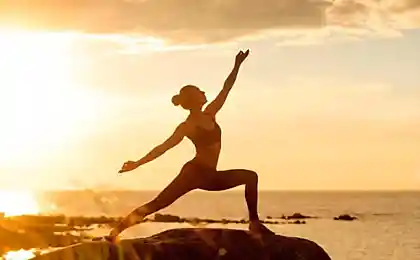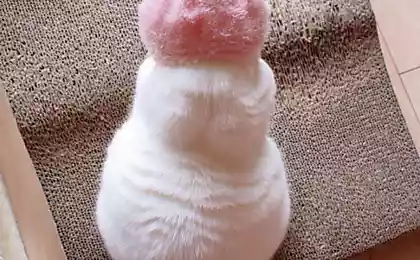836
The practice of asanas: the main complex.

Regular physical exercise are undoubtedly one of the major determinants of health. However, the presence of large muscle does not mean good health.
The system of yoga exercises is different from the normal sports program that does not deplete vitality, and gentle stretches and tones the body, giving a burst of energy and vigor. Healthy and harmonious work of the endocrine glands and internal organs and the nervous system and consciousness - that will give you a regular practice of asanas.
Asanas - yoga poses - have an impact on various systems of the body, making it flexible spine and joints and toning the muscles and internal organs. The main difference from the usual yoga asanas for us to exercise power - a rejection of any sudden movements, which, when repeated many times inevitably lead to fatigue, training of concentration and attention. A special place in a yoga class takes your breath - with proper breathing stimulates the heart, all organs of the body in the required amount of oxygen supplied, while the output of which carbon dioxide and other metabolites. This is particularly important because, as has been proven by scientists are not always large amount of exercise, when a man literally falls from fatigue, gives the maximum effect for their health and muscle tone.
In fact, the asanas - is not so much exercise as posture adopted for the stationary state, and should be done slowly and contemplatively, combined with a deep abdominal breathing.
Each asana consists of three stages - making positions, saving it in and out of poses. This work is going on the asanas, when you save a pose - yoga adherents remain motionless for several hours. As long as you hold the pose you need to stay calm, breathe deeply and slowly, concentrating their minds.
Because of the huge number of existing asanas allocate 84 most important, but for the maintenance and preservation of health is sufficient to carry out only a couple of dozen. Below I will give the main complex, including a little more than a dozen yoga asanas, with explanations, illustrations and therapeutic effect exerted on the human body.
To paint a complete sequence of each pose in this article, I think, would be superfluous, and interested people, if desired, be able to find all the instructions in any policy tool.
Savasana ("mertnaya" posture)
Savasana »style = - is a classic posture of relaxation, which is taken before the start of each set of exercises, between asanas and the final relaxation. When you first lie down, make sure that everything was symmetrical, because symmetry ensures proper space for relaxation of all body parts.
Breathe deeply and slowly, bulging stomach and absorbing plunging into deeper relaxation with each breath. Feel how your belly swell and fall. At this time, there are many important physiological changes, reducing the loss of energy of the body, eliminating stress, reducing perspiration and heart rate and calming the whole body system.
Surya namaskar (complex poses "Hello, Sun!»)
Surya namaskar »style =
It is a series of twelve positions to be performed as one continuous exercise. Each position is the opposite of the previous one, stretching the body in a different way and alternately expanding and contracting the chest to regulate the breathing. The daily repetition of this exercise will provide flexibility to your spine and joints and reduce your waistline.
Sirshasana (posture "headstand»)
(see. fig. 1) - one of the most useful of asanas for the body and for the mind. By changing the normal effects of gravity, it serves to improve the cardiovascular system, blood circulation and eases the pressure on the lower back. With regular exercise, it will help prevent the occurrence of back pain, improve memory, concentration, sensory abilities.
Caution: This asana is contraindicated for people with high blood pressure, glaucoma, and retinal detachment.
Sarvangasana (posture "candles»)
(see. Fig. 2) in Sanskrit means "the pose for all parts of the body." An excellent tonic, it is just as useful as the headstand. The difference is that as the body is at right angles to the head, the neck is stretched and the upper part of the spine and, more importantly, stimulates the thyroid and parathyroid glands chin, abutting the jugular depression. Asan also prevents kidney and bone system, relieves when varicose veins, massages the heart and stimulates mental activity.
Halasana (posture "plow»)
(see. fig. 3) largely affects the body, as well as the shoulder stand: it tells the flexibility of the spine and neck, strengthens the back, shoulders and arms. Because the abdominal muscles are compressed, then there is a massage of the internal organs, thus stimulates the liver and spleen, improves state with dyspepsia and constipation.
sirshasana, sarvangasana, halasana
Matsyasana (posture "fish»)
(see. fig. 4) is the opposite of headstand and must always be carried out after it. Stretching the neck and upper spine, and performing sarvangasanu halasanu now you compress them when arches back, eliminating the stiff neck and shoulders, and correcting any tendency to ssutulivaniyu. This pose develops the chest, tones the nerves of the neck and back and increases the effect on the thyroid and parathyroid glands of Sarvangasana. It also promotes the expansion of the chest, deep breathing and increased lung volume. You should keep this position for at least half of the time you spend in sarvangasane, in order to balance the stretch.
Pashimottanasana (position "lean forward»)
(see. Fig. 5) looks deceptively simple, but it is a very important and difficult pose. Activities of this asana strengthens the internal organs, reduce the amount of fat and stimulate the entire nervous system. It also regulates the intestine and increases peristalsis, helps in diseases of the urinary system and increases the mobility of the hip joint.
Bhudzhangasana (posture "Cobra»)
(see. fig. 6) stretches the spine, tones and massages the internal organs in the abdominal cavity. It is particularly effective when irregular menstruation, and constipation. This asana also eases back pain caused by overexertion or long standing on his feet.
matsyasana, pashimottanasana, bhudzhangasana
Salabhasana (posture "grasshopper»)
(see. Fig. 7) requires to enter the sudden movement. In this position the focus on the lower back; strengthening the abdominal muscles, lower back and legs. As with other back subsidence occurs massage internal organs, ensuring the effective functioning of the digestive system and prevents constipation. With regular exercise you will learn how to reduce lower back muscles to throw your feet up while developing the necessary strength.
Dhanurasana (posture "onion»)
(see. fig. 8) tones the muscles of the back and retains the flexibility of the spine, improving posture and increasing vitality. Transfer the body weight on the stomach reduces body fat, and it provides a good condition of the digestive and reproductive systems. For beginners it is easier to raise your knees when the feet apart; those involved have sufficient time should strive to raise their serried.
Ardha matsendrasana (position "half-twist the spine»)
(see. Fig. 9) is one of the few poses the main complex, which rotates the spine. This movement also tones the spinal nerves and ligaments and improves digestion. Asana has a beneficial effect on the sympathetic nervous system, corrects stooped shoulders and back and improves posture.
salabhasana, dhanurasana, ardha matsendrasana
Kakasana (posture "Crow»)
(see. fig. 10) - a relatively easy posture. The secret to perform is to lean forward far enough and discard all thoughts, focusing only on how to keep your balance. With proper training this asana strengthen the wrist and increase lung capacity by increasing chest.
Pada hastasana (posture "for the arms and legs»)
(see. fig. 11) affects the body as favorable as the position "lean forward" - reducing the waist, restoring the flexibility of the spine and stretching ligaments legs, especially tendon laterally limiting popliteal fossa. It also promotes blood flow to the brain.
Trikonasana (posture "onion»)
(see. fig. 12) complements the movement of "half-twist of the spine" and perfectly stretches the sides of the spine, toning the spinal nerves and promoting the proper functioning of the digestive system. The body becomes lighter, and the other asanas improved.
kakasana falling hastasana, Trikonasana
Practical issues
All you need to practice asanas, - your body surface, soft bedding, if necessary, and a little self-discipline. We must try to take it a rule to deal with asanas every day at the same time; much less useful to perform the exercises, but every day, the more, but with breaks in a few days.
Take a certain time that you can devote yourself, not being distracted by other things. The ideal time to practice - in the evening, before meals, or early in the morning, but in the morning the body less flexible. Whatever time you choose, you need to perform the asanas on an empty stomach. Train barefoot, removing watches and jewelry. Engage in a warm, well-ventilated room or, weather permitting, in the fresh air.
























